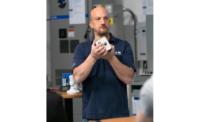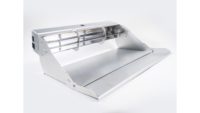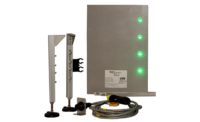Every successful project starts with a framework. A vision statement. A blueprint.
The editors of Engineered Systems are proud to present The Blueprint — a monthly Q&A interview with HVACR engineering’s leading voices. These one-on-one discussions will examine the trade’s history, current industry trends, the factors shaping the sector’s future, and more.
As the COVID-19 virus evolved into a worldwide pandemic, and American citizens were placed on lockdown in numerous states, UV-C’s effectiveness in cleaning indoor air rose to the forefront.
The founders of UV Resources pioneered the application of Ultraviolet Germicidal (UV-C) energy in HVAC/R equipment nearly 25 years ago. Today, the company operates a comprehensive manufacturing and distribution network to supply market-leading UV-C solutions for building engineers, facility managers, HVACR contractors, and OEM equipment manufacturers around the world.
Recently, Dan Jones, president of UV Resources, sat down with Engineered Systems editor-in-chief, Herb Woerpel, to discuss the wide-reaching impact of germicidal UV-C technology, its impact on COVID-19, and more.
Engineered Systems Let’s cut right to the chase. Does UV-C kill the COVID-19 coronavirus?
Jones: Researchers don’t yet know if UV-C can kill COVID-19 as this particular strain has not yet been studied. Although the germicidal UV-C waveform (253.7 nm) is effective in killing other varieties of coronaviruses, such as SARS and MERS, scientists do not yet know about the impact of UV-C on COVID-19. Research has shown that exposure to UV-C is a practical and cost-effective method of inactivating airborne and surface pathogens, including viruses, mycoplasma, bacteria, and fungi. Dosage rates for different pathogens have been determined based on studies completed over the years, and these can be used with predictive modeling to forecast how much UV-C would be necessary to kill individual bacteria, viruses, or spores. For example, viruses like influenza, measles, SARS, and smallpox tend to be more susceptible to UV-C inactivation in an airstream.
Although UV-C technology has been around for centuries, here’s a quick refresher course on its use for HVAC surface and air disinfection today. There are three primary means of applying UV-C systems against infectious agents in this setting: Upper-Room or Upper-Air, HVAC airstream disinfection, and coil/surface irradiation. Upper-Room/Air systems are installed in patient rooms, emergency room waiting areas, cafeterias, classrooms, child care centers —anywhere people with possible infections might congregate. As convection or mechanical air currents lift airborne infectious agents into a room’s Upper-Air region, they are exposed to UV-C irradiation, which breaks the bacteria or virus DNA chain, rendering it unable to reproduce or killing it. Coil-irradiation and airstream-disinfection systems are installed within HVAC air-handling units and duct runs. Coil-irradiation applications prevent microbial growth from impeding HVAC heat transfer efficiency with a secondary benefit of eliminating up to 30% of airborne pathogens on a first-pass basis (and these concentrations are further reduced in recirculated air systems by each subsequent pass or “multiple dosing”). Finally, the third application of UV-C in HVACR systems is killing airborne pathogens, which is typically installed upstream of the cooling coil and requires more UV-C energy.
Figure 1: Since the 1940s, many hospitals have relied upon Germicidal UV-C energy to control airborne infectious diseases but use waned with the arrival and proliferation of antibiotics. In the 1990s, demand for the technology returned following a resurgence of drug-resistant infectious microorganisms; as germicidal UV-C technology kills airborne pathogens without increasing their antibiotic-resistance.
Engineered Systems: Can UV light mitigate the spread of airborne viruses?
Jones: As noted earlier, the ultraviolet germicidal wavelength (UV-C or UVGI) kills all known-microorganisms, including bacteria, viruses, molds, and other pathogens — even antibiotic-resistant superbugs. ASHRAE states that the UV-C wavelength can kill 90% or more of all microorganisms living on HVAC air ducts and evaporator coils, depending on UV-C intensity, length of exposure (aka residence time), UV lamp placement, and lamp life cycle. Operating 24/7/365, Upper-Room germicidal fixtures can inactivate microbes in under a second, including measles, mumps, TB, and cold viruses. In fact, ASHRAE’s position document on airborne infectious diseases (that was just reaffirmed last month) identifies just three proven methods of controlling airborne infection: ventilation, particle filtration, and germicidal UV-C energy. UV-C is such a promising technology that ASHRAE placed its highest research priority on both Upper-Room/Air UV-C and duct/air-handler UV-C equipment.
Engineered Systems: Can COVID-19 (or other viruses) spread through HVAC ducts?
Jones: Although scientists are learning more about this virus every day, authorities currently believe that coronaviruses can be transmitted via air and direct contact. Researchers have found the COVID-19 virus can live in the air for several hours, up to 24 hours on cardboard and up to two to three days on plastic and stainless steel. And just last week, the Centers for Disease Control and Prevention (CDC) said genetic traces of the COVID-19 virus were found on surfaces of the Princess Cruise ship 17 days after passengers disembarked. Therefore, it could be presumed that HVAC systems can, inadvertently, broadcast the infection and amplify its spread. Moreover, because of the extended incubation period for some of these diseases, people can spread the virus before anyone knows they are contagious and, more importantly, before anyone can take precautions. Therefore, it's incumbent on facility engineers to use multi-layer preventive infection-control measures, such as germicidal UV-C to mitigate the potential spread of airborne diseases. A multi-barrier approach helps ensure that whatever pathogen is not “killed” by one method (say filtering or cleaning) is inactivated by another.
Engineered Systems: UV-C can be deployed in numerous ways. First, how does germicidal UV-C “On-The-Fly-Kill” work?
Jones: In-duct germicidal UV-C systems are installed in air-handling units or air distribution systems to inactivate microorganisms and disinfect moving airstreams “on-the-fly”— as well as on HVAC surfaces. This is oversimplified, but, in general, the effectiveness of UV-C air disinfection boils down to time and intensity, i.e., how much time/duration a pathogen is exposed to the UV-C energy will determine how much UV-C intensity is required. While that may sound “easy,” there are many operational conditions that will change this equation. These factors include the target pathogen and its susceptibility to UV-C; the amount of airflow (volume and velocity); the air temperature and RH; the length of exposure time (duct length); and the duct material reflectivity. Each of these factors into the amount of UV-C energy necessary in any given application (installations are typically modeled to help predict individual dosage levels).
For example, to keep cooling coils free from mold and bacteria, lamps might be installed on the downstream side of a coil surface and spaced every 30-40 inches of coil height. This equates to roughly 7.5 lamp watts per square foot, i.e., enough UV-C energy to get the job done. In this example, the target (coil) is stationary, and the exposure time to UV-C is 24/7/365, so the UV-C intensity can be lower.
However, for a moving airstream, UV-C intensity must increase significantly due to the decrease in time that the target pathogen(s) will be exposed to the UV-C energy. Greater UV-C dosage can be achieved by increasing the number of lamp watts per square foot. This is where product design and application come into play (and why installations are computer-modeled). For example, by using a “fixtureless” UV-C system, 360-degree irradiation can be achieved, which allows the UV-C energy to flood the entire plenum. In addition to using 360-degree fixtures, UV-C dosage can be increased by reducing the horizontal distance between lamp rows. For example, instead of 36-inch spacing between rows, 12-inch spacing can be specified to raise UV-C dosage levels.
Another operational consideration is location. Because cold air reduces the output of UV-C lamps and high RH affects pathogen susceptibility to UV-C, on-the-fly airstream disinfection applications are more effective when installed on the upstream side of the coil. In fact, moving UV-C lamps from 55°F temperatures (typical of downstream) to 75°, which is typical of upstream, can increase a UV-C lamp’s output by 40%. With that said, on-the-fly disinfection can be accomplished downstream of the coils; however, this would require an increase in UV-C intensity (i.e., more lamps).
Engineered Systems: You mentioned Upper-Room/Upper-Air UV-C earlier. How exactly does that technology work?
Jones: Upper-Room germicidal UV-C fixtures — ideal for infection control — work by interrupting the transmission of airborne infectious diseases in high traffic communal areas. Immunocompromised and contagious individuals in emergency waiting rooms, urgent care facilities, doctor offices, or senior living centers increase the potential for community spread by positioning potentially undiagnosed/untreated patients near others. As convection or mechanical air currents lift airborne infectious agents into a room’s Upper-Air, they are exposed to UV-C irradiation, which breaks the bacteria or virus DNA chain and renders it incapable of replicating.
Operating 24/7/365, Upper-Room germicidal fixtures can inactivate microbes in under a second including measles, mumps, TB, and cold viruses. These fixtures are wall-mounted 7 feet or above and use baffles to direct the UV-C energy upward and outward ensuring that no UV-C energy enters the occupied portion of the room. Kill ratios of up to 99.9% on a first-pass basis have been modeled and concentrations are further reduced by each subsequent pass of recirculated air (“multiple dosing”). And, again, this is not a new application. Upper-Room UV systems have been used to control airborne infectious diseases since the 1940s, but their use waned during the arrival and proliferation of antibiotics in the 1950s. Demand for the technology increased following a resurgence of drug-resistant infectious microorganisms, including tuberculosis, which requires additional infection control measures.
Figure 1: The high-output GLO™ UV fixture use baffles to direct the Germicidal UV-C wavelength upward and outward to create an intense zone of UV-C irradiation, while minimizing UV irradiation into the lower occupied space.
Engineered Systems: How much area can an Upper-Room UV-C fixture treat?
Jones: Germicidal coverage from an Upper-Room germicidal UV-C fixture varies depending on lamp wattage and fixture/reflector design. UV Resources has two fixtures, the GLO Upper-Room fixture treats 225 square feet (roughly 15 feet out and 7.5 feet from either side, or 15-by-15 feet), while a smaller GLO 150 Upper-Room fixture treats up to 150 square feet (roughly 8 feet out and 9 feet across either side of the fixture). The goal, relative to coverage, is to maintain a minimum of 50 µW/cm2 of UV-C energy.
Engineered Systems: Tell us about the latest products UV Resources has released relating to these applications.
Jones: We just introduced an addition to our ground-breaking GLO Upper-Room UV-C fixture, which is designed to help control airborne pathogens in smaller, individual treatment spaces, such as doctor-patient screening rooms, primary care exam rooms, and dental offices. The original fixture owes its high performance to an engineered-driven reflector design, which delivers up to 350% more UV-C output compared to conventional designs. Using a CAD-designed, high-spectral Alanod aluminum parabolic reflector, we were able to triple UV energy output, which allows infection control specialists to treat more space with fewer fixtures, saving both cost and energy. The new 8-watt GLO 150 treats up to 150 square feet of Upper-Room air, whereas the 25-watt GLO irradiates up to 225 square feet and is typically used in urgent care waiting rooms, hospital surgical suites, cafeterias, and child care centers.
The second product introduction actually packages our most powerful RLM Xtreme fixture with our most sought-after germicidal components into a comprehensive “all-in-one” system. Now, specifying engineers can select all of the UV-C lamp performance, monitoring, and safety solutions in a single order. Ideal for high-volume coil irradiation and on-the-fly treatments, the RLM Xtreme fixtureless UV-C lamp system generates up to twice the ultraviolet irradiation levels versus “fixtured” lamp systems, making it one of the most effective UV-C solutions available today.
Engineered Systems: How has UV Resources adapted its operations due to COVID-19?
Jones: Since the pandemic began, the UV-C industry worldwide has seen an unprecedented surge in demand. Because of this, we thought it important to initiate a weekly update with our reps and distributors to share product availability levels and anticipated lead times, so they could share accurate information with their customers. As well, we have daily updates with our supply chain partners to ensure they are keeping up with our demand. The week of March 9, we suspended all business travel and encouraged staff to use video conferencing services to advise on specification submittals as well as to conduct online product knowledge training. Lastly, we’ve noticed our employees and reps and distributor network have stepped up to meet the unprecedented demand for our application knowledge and technical insights. Although UV Resources helped establish ultraviolet air and surface treatment as a mainstream technology, there is still a surprising amount of doubt and misinformation surrounding UV-C technology, so we’ve redoubled our educational focus and hired a communications manager to oversee these efforts.
Engineered Systems: What else is on the UV Resources’ agenda for 2020? Anything important we should know about?
Jones: That’s a great question. As I suppose as it is with virtually everyone in the U.S., and around the world for that matter, had you asked me that question three weeks ago, my answer would have been completely different than today.
The fact that we are living through a pandemic outbreak has completely reconfigured UV Resources’ priorities this year. The UV-C industry is seeing an unprecedented demand for solutions and products, and our sales managers are working closely with our distributors to help them educate and assist facility managers, engineers and specifiers about how to apply UV-C technology to help combat the spread of infectious disease. Equally as important, we are working very closely with our supply chain partners to ensure a steady flow of components to meet demand
Engineered Systems: So, let’s pretend I’m a facility manager considering UV-C, though I can’t quite pull the trigger. In summary, what two or three points must I know?
Jones: The focus at this moment for engineers and facility managers is infection control and improved IAQ. By using UV-C in both upper air and HVAC systems, they can have the dual benefit of providing a healthier environment for occupants and reducing the performance-robbing impact of bacterial buildup on AHU cooling coils. On the human side, providing “clean air” has become a “premium” and has taken on a whole new meaning of providing a safe environment. On the mechanical side, UV-C energy helps prevent and remediate fouled coils in HVAC systems and the related inefficiencies and higher energy costs. Finally, it reduces the need for frequent HVAC cleanings, especially if a UV lamp is installed, which eliminates the need for manual maintenance, with the exception of an annual bulb change. Cost-concerned managers should understand that UV-C fixtures can be installed for an average of less than $0.15 per cfm — a mere fraction of the 10%-25% potential energy and maintenance savings yielded by the efficiency-enhancing technology.
Engineered Systems: Anything else our audience needs to know?
Jones: The biggest change in demand for UV-C comes from the engineering community. Mechanical engineers want to ensure that the HVAC equipment they’re specifying continues to perform at peak capacity for as long as possible. Equipment designers (OEM’s) appreciate that products have greater value when they perform at full capacity long after startup. The market is starting to view UV-C along the same lines as air filtration … every application works better, longer, and users are happier when UV-C is installed in air handlers.





